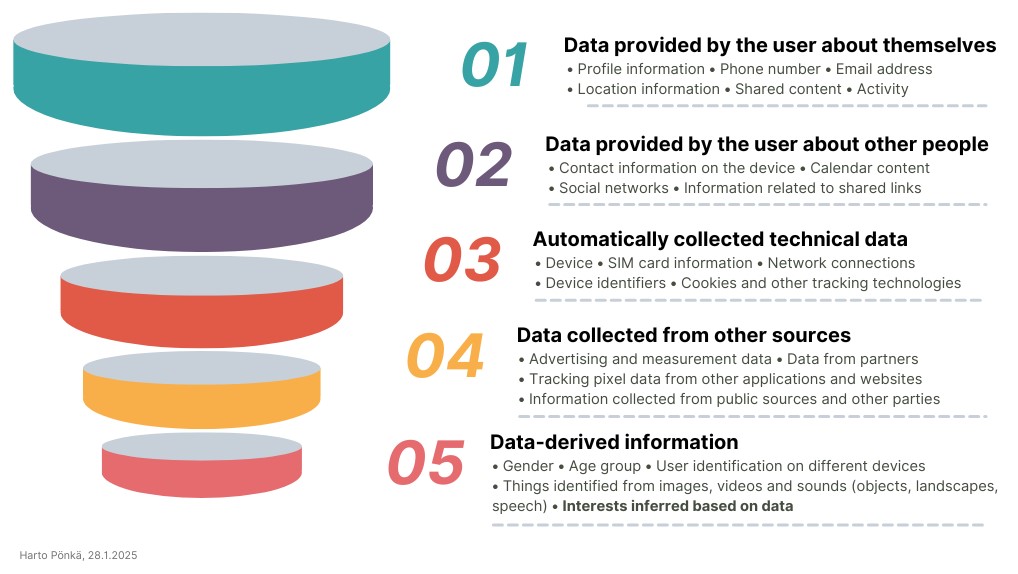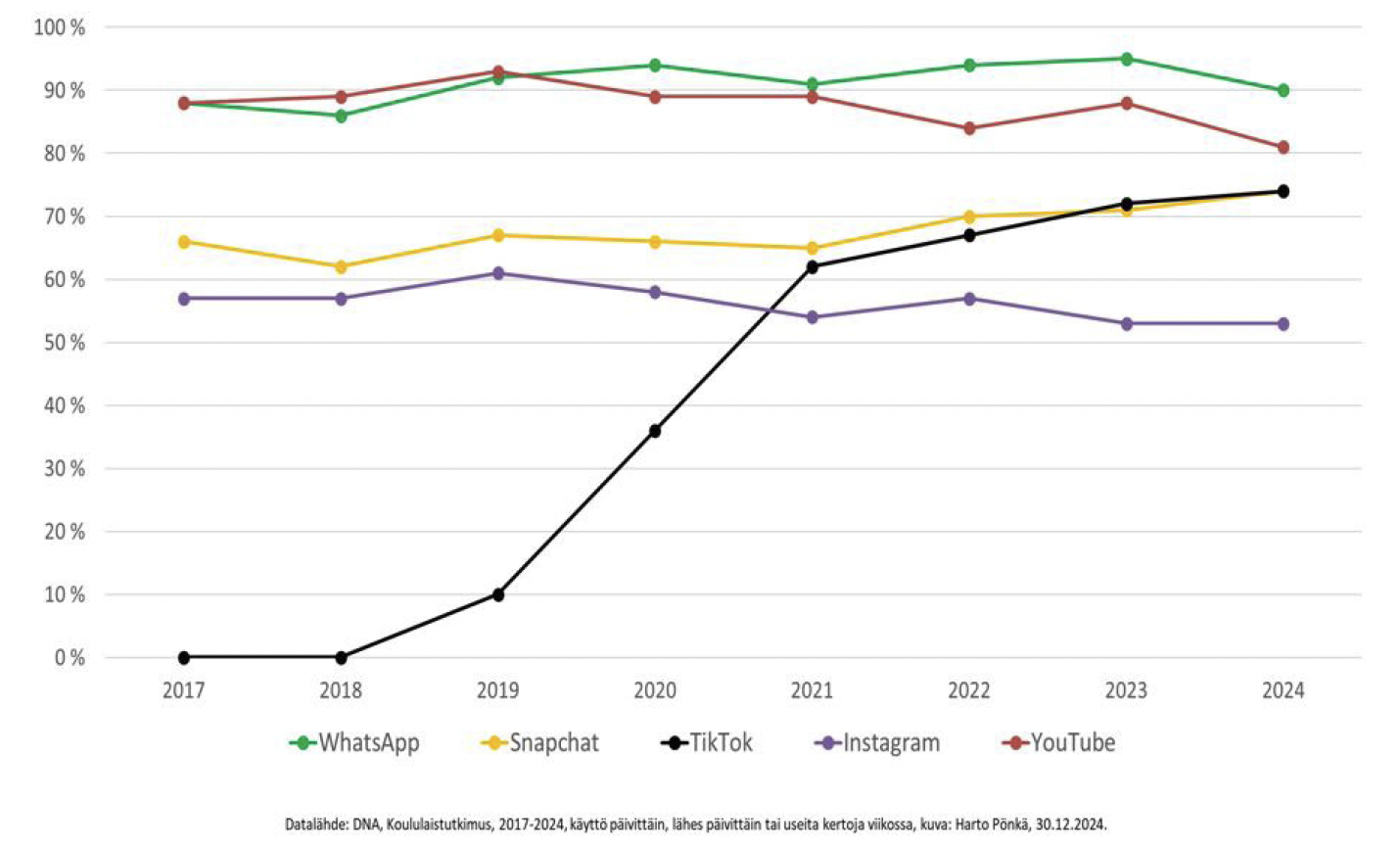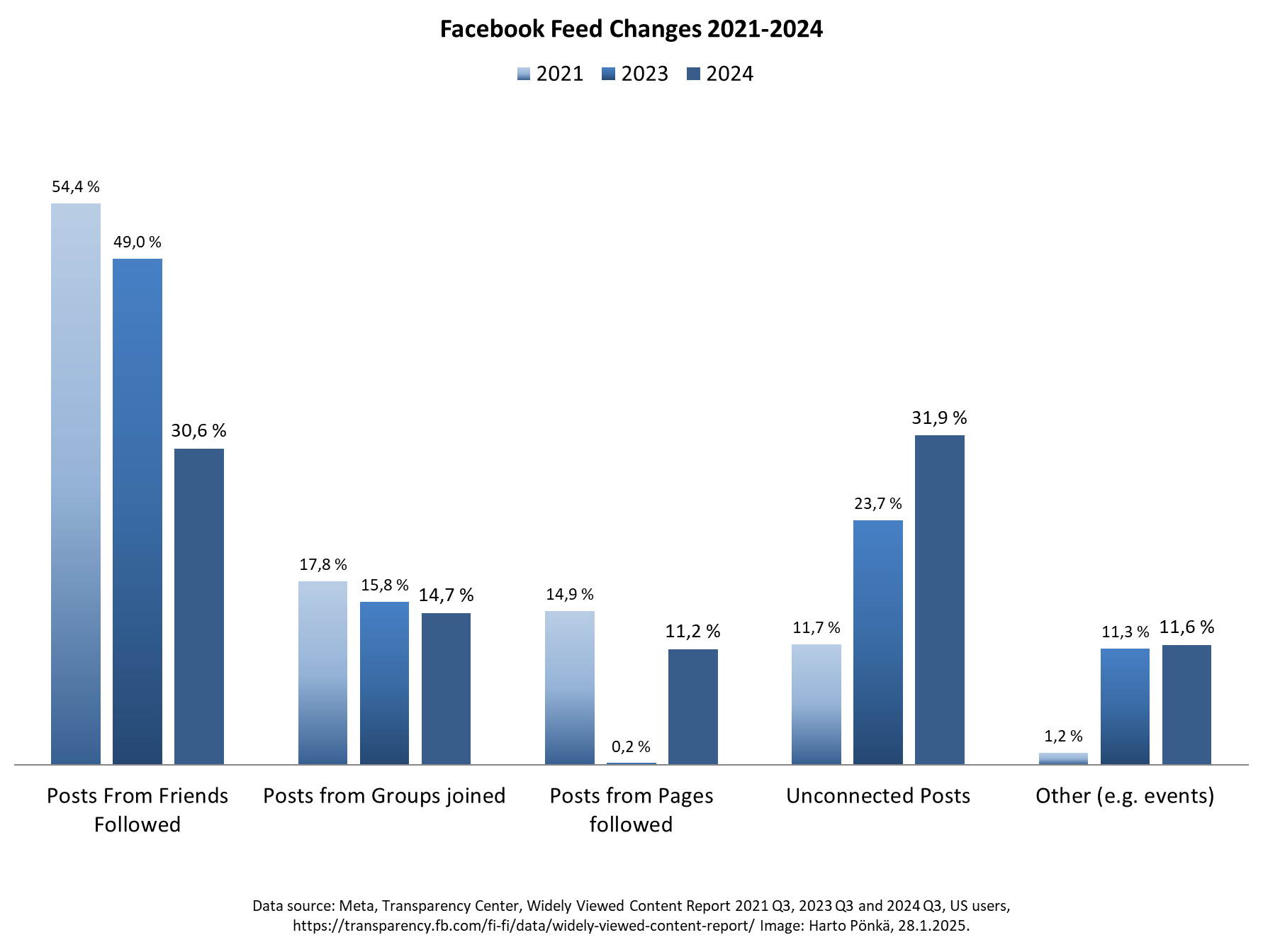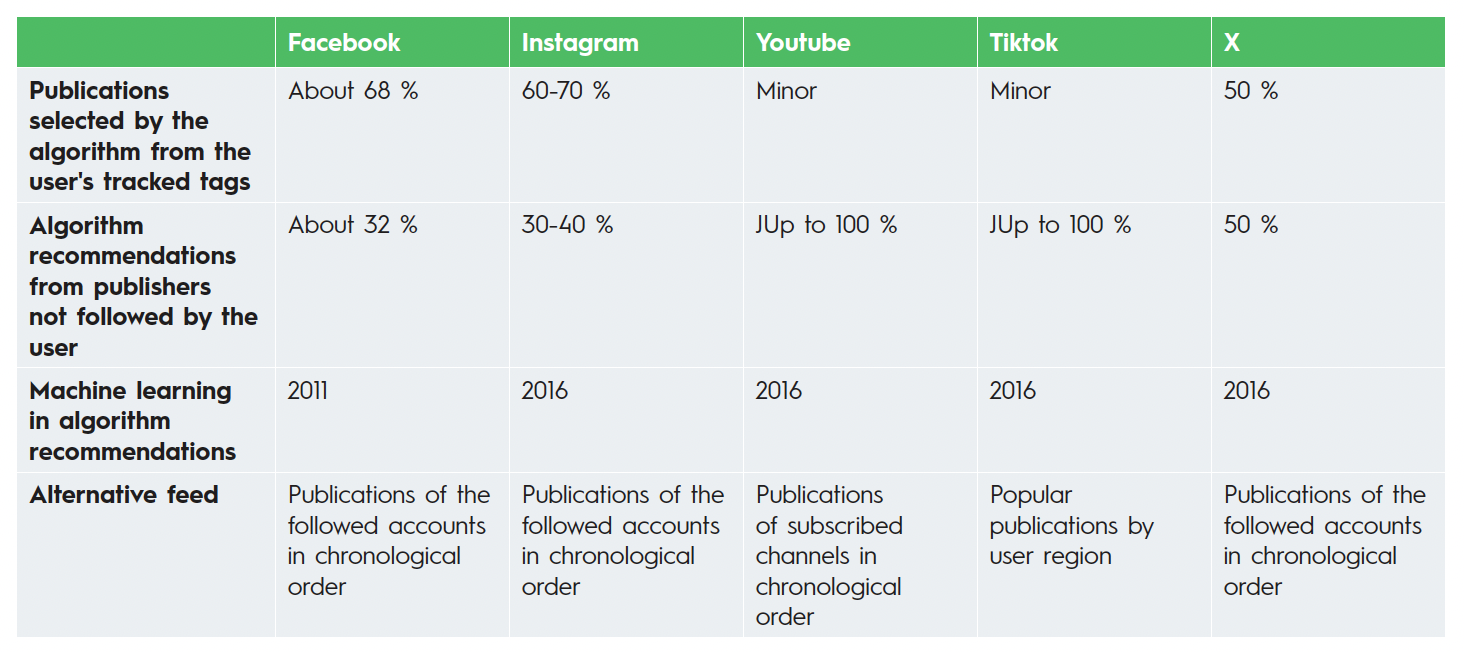When people talk about AI, the first things that come to mind are chatbots like ChatGPT and Copilot, and image generators using AI models. At the same time, it may go unnoticed that we use AI much more often in non-AI applications: namely in social media services.
In the most used social media services, machine learning has been used to make algorithm recommendations since 2016 at the latest. The earliest experiments with recommendation systems were done years earlier.
Different recommendation algorithms
Recommender systems are used in a wide range of information systems and applications. In social media services, they are commonly referred to as recommendation algorithms or personalised algorithms. These are programmes that use machine learning to sift through large amounts of data to generate recommendations that are appropriate for users. Most commonly, it is the generation of content feeds that are visible to users on a social networking site. In effect, recommendation algorithms decide what content to show users on social media services and applications and in what order.
Recommendation systems can be mainly divided into three categories: content-based, collaborative and hybrid models that combine several approaches.[i] [ii]
- A content-based recommendation algorithm makes recommendations by comparing information provided to users and content. For example, the app can ask users what topics they are interested in and then display content that matches the selected categories.
- A collaborative recommendation algorithm makes recommendations based on data collected from users’ activities. The idea is that instead of a single user filtering content, data from multiple users is used to filter content, and users who have been interested in the same topics in the past will be interested in the same topics in the future. The data can include, for example, user reactions to posts and the user’s social network.
- Hybrid recommendation algorithms combine content-based and collaborative approaches with other methods. For example, an algorithm can recommend content to new users based on their location or interests and then move to collaborative recommendations as data about the user’s activity accumulates and can be compared with data about other users and content.
As users’ interests, behaviour and activity levels vary, there has been a growing effort to develop algorithms that are more adaptable to their habits and differences. This is reflected in the proliferation of hybrid recommendation algorithms. For example, a very active social media user will need a much larger number and more recent recommendations than a user who visits an application, say, only a few times a week.
An active social media user needs more recent recommendations than a user who only visits the app a few times a week.
Existing online and social services aim to collect the most accurate information possible about users’ behaviour, so that recommendation algorithms can make the best possible choices for users. This has meant that more and more personal and behavioural data is being collected from users.
As the amount and complexity of user data has increased, applications have developed AI-based recommendation algorithms. The advantage of AI-based algorithms is that they can make efficient use of a large pool of user-specific data and adapt to each user’s behaviour. This means that different variables can be weighted when making recommendations, depending on the data available about the user. This is a clear advantage over rigid recommendation algorithms that follow the same rules for each user.
Existing recommendation algorithms use several AI techniques such as machine learning, deep learning, and natural language processing familiar from conversational bots. On the other hand, despite the use of AI, users may feel that the choices made by social networking algorithms are not suitable for them.
It is good to be aware that the algorithms of online and social services change frequently. These changes are the result of algorithms evolving as social media services seek to optimise their performance to suit their purposes. For example, as artificial intelligence develops, there is a growing effort to use new AI functions in recommendation algorithms.
Whether or not AI is used, it is worth bearing in mind two things that seem to be relatively constant: first, algorithms are generally designed to keep users on the service as long as possible, and second, algorithms are susceptible to manipulation. For example, advertisers, political influencers and disinformation disseminators are constantly studying algorithms to maximise the visibility of their publications.[iii]
For better or worse, Facebook has been a pioneer of AI algorithms. Facebook launched its News Feed two years after the launch of the service in 2006. Initially, there was no recommendation algorithm, but the News Feed contained all the activity of Facebook friends in chronological order.
Facebook released its first algorithm to drive the News Feed in 2009. In retrospect, this event can be seen as the beginning of the social networking recommendation algorithms. The idea was to show users the most interesting content instead of showing them all the posts of their friends. The algorithm mainly used three variables: the proximity of the user to the post, the weight of the content and the time of the post. It was therefore a collaborative recommendation algorithm where the social network between users played a big role. Later, this type of algorithm came to be regarded as a standard one, specifically for networking services.[iv] [v] [vi]
The introduction of the algorithm was a significant change for Facebook’s 300 million users at the time. By no longer “having” to read all their friends’ posts, users were able to network with more and more people. In 2009, the average number of Facebook friends was 120, but by 2011 the number had grown to 190. That’s when another major change was made to the News Feed algorithm, with the introduction of a machine learning-based recommendation algorithm[vii].
By 2013, the new AI-based recommendation algorithm used up to 100,000 different variables. This meant increasingly personalised recommendations: users who were active in Facebook groups saw more group posts. Those who frequently liked photos saw more and more photo posts. In turn, those who clicked on links were offered more links, and so on[viii].
As AI sifted through the most interesting posts on the social network, users were able to network with more and more of them without cluttering up the News Feed with uninteresting “noise”. In 2016, the average US user already had 350 Facebook friends, and as many as 650 for 18–24-year-olds.
In the early years, Facebook had been a platform for communication between friends, but the growth in friends meant the possibility of ever greater publicity. The importance of links shared on Facebook became even more important for commercial entities, as organic visibility on Facebook could mean thousands and thousands of visitors to a company’s website. Alongside social networking, the motives for using Facebook may have become mass appeal, business and political influence. Facebook’s own employees described the change as a collapse of context[ix].
In 2016, Facebook released emoji reactions of “love”, “haha”, “wow”, “sad” and “angry”. These allowed the algorithm to infer users’ emotional state and recommend posts that matched it. At the same time, the hybrid AI recommendation algorithm became so complex that it proved difficult for Facebook to manage.
There was one serious problem with the effect of emoji reactions on the recommendation algorithm. Emoji reactions were given many times the weight of normal likes when calculating the algorithm’s recommendation score. As a result, posts with strong reactions such as “angry” and “haha” emojis could gain disproportionate visibility when the algorithm picked them up in user feeds. Thus, triggering anger and other strong emotions became an effective way to get posts wide visibility on Facebook. This did not go unnoticed by those seeking[x][xi] [xii].
Generating anger and other strong emotions became an effective way of getting posts widely seen on Facebook.
It took Facebook years to realise and correct the disproportionate impact of emoji reactions on the functioning of the recommendation algorithm. In 2021, according to documents leaked by a former Facebook employee, Facebook had tried to prevent emotional reactions from over-influencing recommendations, but a feature developed for this purpose did not work. Tellingly, the News Feed algorithm could give high visibility to posts containing disinformation, hate speech and clickbait, for example, while the company’s moderators did their best to weed out such content.
Facebook researchers discovered the use of emoji reactions to spread inaccurate and harmful content in 2019. The impact of angry reactions on the recommendation algorithm was calculated several times and finally reset in 2021 after Facebook came under heavy public criticism in the aftermath of the 2016 and 2020 US presidential elections. The company was accused of failing to combat disinformation and election interference. Emotional Facebook posts were also used effectively in the campaign for the 2019 Finnish parliamentary elections[xiii].
After 2021, Facebook has continued to develop its AI-driven recommendation algorithm. With increasing data protection regulation, Facebook has started to regularly publish information on which posts the algorithm selects for the average Facebook user’s feed. In recent years, Facebook has reduced the visibility of links in particular, and increased the number of posts whose publishers are not part of the user’s network of Facebook friends. These changes mean that Facebook is increasingly seeking to keep users on its service and is gradually moving towards interest-based recommendation based on profiling, where users’ social network plays an increasingly less important role[xiv].
YouTube’s problem: which of the millions of videos to recommend next?
YouTube’s need for an efficient recommendation algorithm was obvious when, just three years after the service’s launch in 2008, more than 45 million videos had been uploaded to the site. Videos could be browsed by channel, ranked by popularity, and via text-based search. However, the search function did not work very well, as for most videos the only search criteria that could be used was the title of the video[xv].
The closest to YouTube’s need to develop a recommendation algorithm was a competition sponsored by Netflix in 2006–2009 to develop the most accurate movie recommendation system possible. Netflix had started renting DVD movies by mail and had a database of around 100,000 DVDs at the time. The company promised $1 million to anyone who could develop a recommendation system that was at least 10% better than its algorithm at the time. Compared to Netflix, YouTube had a much larger selection of videos and less information about its users.
Google started developing machine learning for video recommendations on YouTube in 2007. The company’s researchers decided to create a network of videos based on how many times the same users had watched the same video. Presumably, it made sense for users to recommend videos that had been watched before by users interested in the same videos. The challenge was the large number of videos, which made it impossible to calculate new video recommendations for each user every time they switched between different videos. On the other hand, the aim was not to suggest only the most popular videos to users, but to allow them to find new content of interest.
As a solution, YouTube’s developers created several AI models that used log data from users as machine learning data. The AI models were able to suggest various “related videos” to users based on videos they had just watched. This was the beginning of one of the early collaborative filtering-based social media recommendation algorithms. Unlike Facebook, the recommendation was not based on the social network of users, but on a network of videos.
YouTube has been a pioneer in the development of AI functions beyond the recommendation algorithms. In 2009, YouTube launched automatic video subtitling based on speech recognition, and in 2013, facial recognition for people and animals, such as cats.
YouTube has been a pioneer in the development of artificial intelligence functions.
It is unclear how long YouTube’s early AI algorithm was used to recommend videos. However, in 2016, a more sophisticated recommendation algorithm using deep learning and neural networks was introduced. The new AI-based algorithm allowed for more efficient moderation of content to automatically identify content that was e.g. inappropriate or otherwise harmful to children. Since 2017, YouTube has been working to boost content from trusted media in the algorithm. In 2019, YouTube further refined the algorithm to reduce the number of recommendations for videos containing questionable claims.[xvi] [xvii]
TikTok’s addictive algorithm
TikTok is new compared to many other social networking services. Its sister app Douyin was launched in China in 2016, and TikTok in other countries the following year. In Finland, TikTok became particularly popular between 2019 and 2021[xviii].
TikTok’s parent company ByteDance is primarily an AI company. One of its first products in 2012 was the Chinese news recommendation app Toutiao, based on a user-personalised recommendation algorithm using machine learning and natural language processing. In 2015, short videos were added to the app, and the following year Toutiao was already the most popular short video service in China[xix].
Unlike many other social media services, ByteDance had a powerful recommendation algorithm in place when it launched Douyin and TikTok. It is worth noting that TikTok’s “invention” was not short videos as a form of content, but rather a recommendation algorithm that managed to capture the interest of users. At the time, there were already many widely used short video apps such as Vine (2012–[xx][xxi]. TikTok combined public short videos with an AI algorithm based on profiling, which recommends videos of interest to users based on data.
TikTok’s “invention” was not short videos as a form of content, but a recommendation algorithm that managed to capture the interest of users.
The core of TikTok is the For You Page, which is made up of recommendations from the algorithm. The typical use of the application is to quickly browse the feed and watch interesting videos. Since viewing decisions are based on the video’s opening image, title and start, visual interest and attention-grabbing are key. This is underlined by the fact that, like many other social media services, TikTok’s algorithm is not based on which publishers the user has tracked, but on what topics and what kind of videos the user has watched in the past.
According to TikTok, the following factors, among others, influence the recommendation of videos in the For You feed:
- User interactions: videos liked, shared, commented, watched, skipped and accounts followed.
- Video data: voices, hashtags, captions, view counts and countries of publication.
- User data: device settings, language, location, time zone and day, and device type.
Compared to other social media services, TikTok’s data collection is very extensive. TikTok’s data collection can be divided into five levels as shown in the figure below[xxii]:
- User self-reported data
- Data provided by the user about other people
- Automatically collected technical data
- Data collected from other sources
- Data derived from the data

By comparing the data collected from the user and the video data, the likely interest of each video to the user is determined. Different factors are weighted in different ways. For example, watching a video from start to finish is a strong indicator that a user is interested in the content of a particular topic. The mere fact that a publisher has many followers does not make their videos superior to others in the recommendation system. The social network, i.e. the number of followers, does not play a major role in the operation of the TikTok algorithm. The TikTok algorithm can be characterised as a recommendation system driven by the interest network.
TikTok’s algorithm is very reactive: the user’s actions on the platform quickly influence the videos that are shown to him in the future. This makes TikTok very addictive for its users. According to internal company documents leaked in 2024 about the lawsuits filed against TikTok in the US, users could be hooked in 35 minutes and fall into a filter bubble created by the algorithm in as little as 20 minutes[xxiii].
Short videos are particularly appealing to young people
The worldwide popularity of TikTok has set the pace for the development of social media services in recent years. As with many other social media services, the growth in TikTok’s user base was initially driven mainly by children and young people, who quickly adopted the new application.
Before the rise of TikTok, the most popular social media services among young people in Finland were WhatsApp, YouTube, Snapchat and Instagram. The popularity of WhatsApp and Snapchat has been based mainly on instant messages and groups between users, video content on YouTube, and photo content on Instagram. TikTok’s short videos offered a new type of content compared to previous social media services and spread rapidly among young Finns from 2019 onwards. By 2021, TikTok was already more popular than Instagram and on par with Snapchat among 13–16-year-olds. However, TikTok’s entry into the market does not seem to have reduced the use of other popular social media services by young people much.[xxiv]


Figure: most popular social media services for 13–16-year-olds in Finland 2017–2024
TikTok’s popularity has not gone unnoticed by other social media giants. With the release of Instagram’s Reels videos in August 2020 and YouTube’s Shorts videos in July 2021, TikTok can be considered the biggest challenger to Instagram and YouTube as a video service – especially among young users. It is therefore understandable that they are trying to offer short videos similar to TikTok.
Short video services have changed and continue to change the way people use social media. This is reflected, for example, in the fact that in just a few years short videos have become more popular in many countries as a way of following the news than long videos or live video broadcasts. According to a study by the Reuters Institute (2024), news videos are most viewed globally on YouTube, Facebook, Instagram and TikTok. Instagram and TikTok are particularly popular among people under 35. TikTok is also becoming an increasingly important news channel in the Global South.[xxv]
Short video services have changed and continue to change the way people use social media.
The question of news monitoring is whether there is a difference in the reliability of news received through different channels. According to several surveys, TikTok users often perceive the news they receive via TikTok as unreliable. In a Reuters survey, the most frequent difficulty in verifying the reliability of news on TikTok was perceived to be the difficulty of verifying the reliability of news on TikTok. It was followed by X, Facebook, and Instagram. In Finland, the results matched the average for the countries surveyed.[xxvi]
In Finland, the effects of TikTok and the short video boom have been felt quickly. According to a survey published in early 2024, TikToki had become the most popular news channel among young Finns aged 13–18, with 33% saying they got all the news they needed. The second most popular news channel was the websites of tabloid newspapers and the third was Instagram. Most[xxvii]. This is a rapid change, which means that young people’s media consumption is very different from that of most of the adult population. There is concern that a relatively high proportion of TikTok users (35%) could not say whether they had encountered[xxviii]. This reflects both the need for digital information literacy among young social media users and the difficulty of detecting disinformation on a short video service in particular.
The growing power of data-driven algorithms
While the most visible impact of TikTok is the proliferation of short videos, it’s worth remembering that the secret to its success is not short videos per se, but a powerful recommendation algorithm. It is also about the extent to which the content recommendations of the algorithm are used by the service.
The success of TikTok – and YouTube before it – has shown that an AI recommendation algorithm based on profiling and interest networks can be more effective in capturing users’ interest than an algorithm based on social networking and collaborative filtering. In TikTok’s algorithm, social relationships between users play little role. This is a significant difference, especially compared to the algorithms of Facebook, Instagram and X (formerly Twitter), which were originally built on the social network of users.
Meta has been open about the development of its recommendation algorithms. In response to TikTok’s competition, Meta has invested in the use of AI in recent years, for example in its Instagram Reels algorithm. In early 2021, Meta announced that it had developed a continuous self-learning AI model for Reels based on the analysis of video audio and video images.
The results of the image and speech recognition of videos are combined with the analysis of their titles and captions, enabling the AI model to generate more accurate video recommendations that match the user’s interests. Like TikTok, Instagram also collects a significant amount of profiling data, i.e. signals related to a user’s activity, to infer their preferences.[xxix] [xxx]
Meta has also increased the use of profiling data in Facebook’s feed algorithm. This is reflected in the fact that more and more of the posts selected by the algorithm for the feed are so-called unlinked posts, i.e. posts by publishers that users do not follow. In 2021, only around 12% of the posts in the feed were, on average, from untracked publishers, but in 2024 this figure had risen to around 32%. At the same time, posts from Facebook friends in particular show up less and less in the feed. In other words, users’ preferences and social relationships have less and less influence on what they see on Facebook.[xxxi]

Figure: Facebook feed changes 2021–2024
An interesting question is to what extent the algorithms of social services respond to users’ needs. One answer to this question is provided by a study by Taylor and Choi, who investigated how the content of different social networking services responded to users’ personal preferences. Participants rated the performance of algorithms on Facebook, Instagram, Twitter and TikTok based on a total of 15 statements.
Eight of the statements were related to the desired behaviour of the algorithm and seven to the undesired behaviour. Based on the results, the content selected by the TikTok algorithm was found to reinforce and meet participants’ goals more often than Facebook, Instagram and Twitter. The Facebook algorithm was perceived to provide the most recommendations that did not meet users’ goals. The study was conducted between 2021 and 2022, before Facebook increased the proportion of non-tracked posts in the algorithm’s recommendations[xxxii]. On the other hand, it is worth noting that participating in research based on algorithms requires a quite advanced level of algorithm awareness and algorithm literacy, so that participants can compare the performance of algorithms in different applications.
The trend in the development of recommender algorithms in recent years can be summarised by the increasing importance of data-driven algorithms compared to socially-driven algorithms. This can be expected to further change the way social media is used in the near future. At the same time, data-driven AI-based algorithms will increasingly influence the behaviour of billions of social media users at both individual and community level[xxxiii].
AI-powered hyper-personalised recommendation algorithms mean that algorithms, rather than users, will have increasing control over what we see across social media services and other digital platforms. After all, algorithms are developed according to the goals of platform owners, not users. On the other hand, the above-mentioned research comparing algorithms across different social services suggests that data-driven algorithms may be more responsive to users’ needs than socially-driven ones.
Algorithm regulation bites badly
The impact of digital platforms on users is not limited to the user experience per se. For example, the impact on privacy of data collection by platforms, the veracity of content recommended by algorithms, the ability to block harmful content and hate speech, and ultimately the impact on the overall well-being of users, must be assessed. Many EU regulations such as the General Data Protection Regulation (GDPR), the Digital Services Regulation (DSA) and the Artificial Intelligence Regulation (AI Act) are also relevant. Since 2018, GDPR has had an impact on how digital giants collect and use user data. For example, Meta and TikTok have been fined hundreds of millions of euros under the GDPR for failures in the processing of children’s personal data.[xxxiv]
The Digital Services Regulation came into force in February 2024, bringing several new rights for users of digital services. The Regulation prohibits the targeting of advertising based on specific personal data such as health, political opinions, ethnic origin or beliefs. In addition, minors may not be targeted based on profiling[xxxv].
The Digital Services Regulation requires online services to be transparent about how their referral systems work. A wealth of information on the functioning of the algorithms of different social networking services is therefore available. At the same time, it should be noted that this information is often incomplete and arbitrary. For example, Meta publishes a lot of information on how its algorithms work, but there is little information on the weighting of feeds and the actual amount of content on Instagram and Threads, for example. For those interested in how algorithms work, the most illuminating sources of information remain data leaks, studies and practical experiments.
The Digital Services Regulation introduced an obligation for large online platforms to offer an alternative to the recommendation system that is not based on user profiling. The table below summarises the normal functioning of Facebook, Instagram, YouTube, TikTok and X algorithms and the alternatives they offer to a profiling-based algorithm.

For example, YouTube is still reasonably easy to use, with the ability to track people of interest. The same goes for Facebook, Instagram and X: all of them allow you to see what the social network has posted recently. In contrast, TikTok’s alternative to the AI-driven “You” feed is odd: the user is then shown videos that are popular in their area[xxxvi]. In practice, TikTok’s alternative is a random feed that hardly interests anyone. Thus, it meets the DSA requirement, but the benefit to users approaches zero.
TikTok is also a cautionary tale of an application that publicly claims to meet the requirements of the DSA, but whose practical measures do not provide users with the benefits that the DSA is intended to deliver. TikTok has had, among other things, major shortcomings in removing illegal content and blocking underage users. In addition, the transparency requirements of the Digital Services Regulation are of little use if the truthfulness of the reports produced by the company cannot be verified[xxxvii].
Read the entire AI Guide for Teachers here.
Sources
[i] Wikipedia. (28.12.2024). Recommender system, https://en.wikipedia.org/w/index.php?title=Recommender_system&oldid=1265732754
[ii] Wikipedia. (12.12.2024). Collaborative filtering, https://en.wikipedia.org/w/index.php?title=Collaborative_filtering&oldid=1262596993
[iii] TikTok. (19.6.2020). How TikTok recommends videos #ForYou, https://newsroom.tiktok.com/en-gb/how-tiktok-recommends-videos-foryou-eu
[iv] McGee, M. (16.8.2013). EdgeRank Is Dead: Facebook’s News Feed Algorithm Now Has Close To 100K Weight Factors, https://martech.org/edgerank-is-dead-facebooks-news-feed-algorithm-now-has-close-to-100k-weight-factors/
[v] Facebook. (27.4.2009). Facebook press room, saatavissa Archive.org-palvelun kautta: https://web.archive.org/web/20090427160416/http://www.facebook.com//press//info.php?statistics
[vi] Wallaroo. (2024). Facebook News Feed Algorithm History, viitattu 9.12.2024, https://wallaroomedia.com/facebook-newsfeed-algorithm-history/#one
[vii] McGee, M. (16.8.2013). EdgeRank Is Dead: Facebook’s News Feed Algorithm Now Has Close To 100K Weight Factors https://martech.org/edgerank-is-dead-facebooks-news-feed-algorithm-now-has-close-to-100k-weight-factors/
[viii] McGee, M. (16.8.2013). EdgeRank Is Dead: Facebook’s News Feed Algorithm Now Has Close To 100K Weight Factors , https://martech.org/edgerank-is-dead-facebooks-news-feed-algorithm-now-has-close-to-100k-weight-factors/
[ix] Pönkä, H. (31.8.2016). Facebook meni rikki, https://harto.wordpress.com/2016/08/31/facebook-meni-rikki/
[x] Pönkä, H. (31.10.2021). Infografiikka: Facebookin viha-reaktio ja algoritmin muutokset, https://harto.wordpress.com/2021/10/31/infografiikka-facebookin-viha-reaktio-ja-algoritmin-muutokset/
[xii] Owen, L. (15.4.2019). One year in, Facebook’s big algorithm change has spurred an angry, Fox News-dominated — and very engaged! — News Feed, https://www.niemanlab.org/2019/03/one-year-in-facebooks-big-algorithm-change-has-spurred-an-angry-fox-news-dominated-and-very-engaged-news-feed/
[xiii] Knuutila, A. & Laaksonen, S-M. (2020). Viraali vihaisuus ja tahmea nauru: tunteet ja algoritmit digitaalisessa vaalikampanjoinnissa, julkaisussa S Borg , E Kestilä-Kekkonen & H Wass (toim) , Politiikan ilmastonmuutos : Eduskuntavaalitutkimus 2019 . Oikeusministeriön julkaisuja. Selvityksiä ja ohjeita , Nro 2020:5, Oikeusministeriö, https://julkaisut.valtioneuvosto.fi/handle/10024/162429
[xiv] Meta. (2024). Facebook Transparency Center, Widely viewed content report: What People See on Facebook, Q3 2024, viitattu 11.12.2024, https://transparency.meta.com/fi-fi/data/widely-viewed-content-report/
[xv] Baluja, S., Seth, R., Sivakumar, D., Jing, Y., Yagnik, J., Kumar, S., Ravichandran, D. & Aly, M. (2008). Video suggestion and discovery for youtube: taking random walks through the view graph, https://static.googleusercontent.com/media/research.google.com/fi//pubs/archive/34407.pdf
[xvi] Youtube. (15.9.2021). On YouTube’s recommendation system, https://blog.youtube/inside-youtube/on-youtubes-recommendation-system/
[xvii] YouTube. (n.d.). Videosuositukset: Miten YouTuben suositusjärjestelmä toimii?, viitattu 11.12.2024, https://www.youtube.com/intl/ALL_fi/howyoutubeworks/product-features/recommendations/#signals-used-to-recommend-content
[xviii] Wikipedia. (31.12.2024). TikTok, https://en.wikipedia.org/w/index.php?title=TikTok&oldid=1266416079
[xix] Wikipedia. (7.9.2024). Toutiao, https://en.wikipedia.org/w/index.php?title=Toutiao&oldid=1244468033
[xx] Wikipedia. (26.12.2024). Snapchat, https://en.wikipedia.org/w/index.php?title=Snapchat&oldid=1265349499
[xxi] Wikipedia. (21.11.2024). Vine (service), https://en.wikipedia.org/w/index.php?title=Vine_(service)&oldid=1258710466
[xxii] Pönkä, H. (29.4.2024). Uusi selvitys TikTokin riskeistä ja raportti TikTokin Kiina-yhteyksistä, https://harto.wordpress.com/2024/04/29/uusi-selvitys-tiktokin-riskeista-ja-raportti-tiktokin-kiina-yhteyksista/
[xxiii] NPR. (11.10.2024). TikTok executives know about app’s effect on teens, lawsuit documents allege, https://www.npr.org/2024/10/11/g-s1-27676/tiktok-redacted-documents-in-teen-safety-lawsuit-revealed
[xxiv] DNA. (n.d.). koululaistutkimukset vuosilta 2017-2024, viitattu 28.12.2024, https://corporate.dna.fi/medialle/dnan-tutkimukset/
[xxv] Reuters Institute. (2024). Digital News Report 2024, https://reutersinstitute.politics.ox.ac.uk/digital-news-report/2024
[xxvi] Reuters Institute. (2024). Digital News Report 2024, https://reutersinstitute.politics.ox.ac.uk/digital-news-report/2024
[xxvii] Uutismedian liitto. (29.1.2024). Uutisten viikon tutkimus: Tiktok on noussut nuorten tärkeimmäksi uutiskanavaksi, kiinnostus omaan elämään liittyviin uutisiin kasvussa, https://www.uutismediat.fi/ajankohtaista/uutisten-viikon-tutkimus-tiktok-on-noussut-nuorten-tarkeimmaksi-uutiskanavaksi-kiinnostus-omaan-elamaan-liittyviin-uutisiin-kasvussa/
[xxviii] Grönlund, M., Horowitz, M. & Lehtisaari, K. (22.1.2024). Luottamusta rakentamassa, luottamusta kokemassa: Mediapäättäjien ja journalismin yleisöjen näkemyksiä, DECA-hanke, https://cdn.prod.website-files.com/64123799970e0ddca93c317a/65af9e00c156d47a2e021807_Luottamusta%20rakentamassa%2C%20luottamusta%20kokemassa_taitettu_FINAL.pdf
[xxix] Meta. (12.3.2021). Learning from videos to understand the world, https://ai.meta.com/blog/learning-from-videos-to-understand-the-world/
[xxx] Meta. (13.12.2024). Instagram Reels Chaining -tekoälyjärjestelmä, https://transparency.meta.com/features/explaining-ranking/ig-reels-chaining/
[xxxi] Meta. (2024). Facebook Transparency Center, Widely viewed content report: What People See on Facebook, Q3 2024, viitattu 11.12.2024, https://transparency.meta.com/fi-fi/data/widely-viewed-content-report/
[xxxii] Taylor, S. H. & ja Choi, M. (2022). An Initial Conceptualization of Algorithm Responsiveness: Comparing Perceptions of Algorithms Across Social Media Platforms, https://journals.sagepub.com/doi/10.1177/20563051221144322
[xxxiii] Stone, S. (19.10.2023). Mastering Social Media Algorithms: The Interest Graph vs the Social Graph, https://www.theshelf.com/the-blog/social-media-algorithms-interest-graph-vs-social-graph/
[xxxiv] CMS Law.Tax. (n.d.). GDPR Enforcement Tracker, viitattu 30.12.2024, https://www.enforcementtracker.com/
[xxxv] Euroopan komissio. (n.d.). EU:n digipalvelusäädös, viitattu 30.12.2024, https://commission.europa.eu/strategy-and-policy/priorities-2019-2024/europe-fit-digital-age/digital-services-act_fi
[xxxvi] Sitra. (3.4.2024). How to turn off recommendation algoriths on the main social media platforms, https://www.sitra.fi/en/articles/how-to-turn-off-recommendation-algorithms-on-the-main-social-media-platforms/
[xxxvii] Pönkä, H. & Mikko, S. (28.10.2024). Mitä hyötyä digipalvelusäädöksestä on diginatiiville? Tarkastelussa Tiktok, Faktabaari
Read the entire AI Guide for Teachers here.

